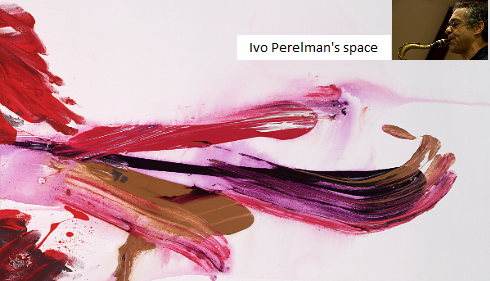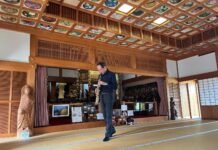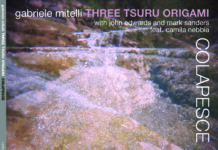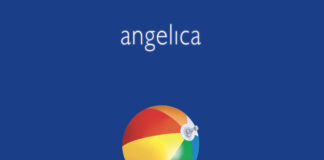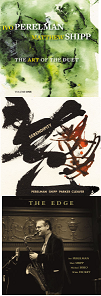 “The art of duet volume one” is the first of a three-volume series of duets between Ivo Perelman and Matthew Shipp: it reminds us some essential aspects of the combination of sax-piano in jazz, those linking the intimacy of the artist with his expressive characteristics: the role of “The art of duet volume one” is precisely to dissect the thought and feeling of the two musicians, putting aside the need to build something that, musically, must be observed at all costs: the task is to order the good ideas to make a code: all thirteen pieces have a link, such as fragments of a larger story: they want to avoid the usual labeling of decomposed free jazz and outline a puzzle of sounds (the fruit of the interiority) that just needs to be heard, without names: Shipp’s piano is very exposed to contemporary music, and it indicates a “path” (with a texture that generates a sense of uncertain adventure, almost like a Monk compressed in the story of Hansel and Gretel, with frequent and irrational speedups), while Perelman seems to paint rather than playing the sax, a capacity to generate different sounds and sensations that go back to his paintings: calm, deeply felt descriptions, prolonged erosions, spikes that stand between the Munch’s anxiety and the irrepressible dripping of Pollock; they are elements of an unbounded artistic maturity that can be placed in the most important representations of the sax and piano jazz duo (Waldron-Lacy, Braxton-Cryspell, Bergman-Parker).
“The art of duet volume one” is the first of a three-volume series of duets between Ivo Perelman and Matthew Shipp: it reminds us some essential aspects of the combination of sax-piano in jazz, those linking the intimacy of the artist with his expressive characteristics: the role of “The art of duet volume one” is precisely to dissect the thought and feeling of the two musicians, putting aside the need to build something that, musically, must be observed at all costs: the task is to order the good ideas to make a code: all thirteen pieces have a link, such as fragments of a larger story: they want to avoid the usual labeling of decomposed free jazz and outline a puzzle of sounds (the fruit of the interiority) that just needs to be heard, without names: Shipp’s piano is very exposed to contemporary music, and it indicates a “path” (with a texture that generates a sense of uncertain adventure, almost like a Monk compressed in the story of Hansel and Gretel, with frequent and irrational speedups), while Perelman seems to paint rather than playing the sax, a capacity to generate different sounds and sensations that go back to his paintings: calm, deeply felt descriptions, prolonged erosions, spikes that stand between the Munch’s anxiety and the irrepressible dripping of Pollock; they are elements of an unbounded artistic maturity that can be placed in the most important representations of the sax and piano jazz duo (Waldron-Lacy, Braxton-Cryspell, Bergman-Parker).“Serendipity” is a long suite of 43 minutes of a quartet of excellence formed by Perelman, Shipp and a rhythm section consists of William Parker on bass and Gerard Cleaver on drums. Such as in the best forms of a live concert, it starts immediately with momentum, supported by a rhythmic structure that looks like a railway engine: Parker with an inexorable and ubiquitous bass + Cleaver with an itinerant percussive game; Perelman inflames the set since the early minutes with his boiling load expressive, reaching spikes of real musical schizophrenia. Shipp tries to emerge in the central “pause” of the improvisation, but he sends fascinating obliques messages at the end of the piece. A dip in the free jazz quartets of heroic historical memory. You might connect to the Live at the Knitting Factory ’96 with Parker and Rashied Ali. Good vibrations, which also suggests a certain spiritual jazz of the past. How many musicians today are able to play in this way?
“The Edge” changes the rhythm section, with Michael Bisio and Whit Dickey: adventure and spirituality are transformed into drama and formalism; in “Clarinblasen” there is the tragic force of a sax screaming in a chamber dimension; anxiety and urgency of “Lancaster” is accompanied by the soft touch of “Epigraph” (echoes of Desmond); expressionist flashes of genius are dished out in the title-track, where Shipp and Perelman (in top form) are launching tender and tormented notes all the time, and the rhythm does not seek its own autonomy, because it must preserve the expression of saxophonist maintaining its original rules. The last two tracks are emblematic: the impact force determined by the process of erosion of “Volcanic” (ten minutes of incandescent) gives way to the five minutes of “Websterisms” an unexpected tribute to the unmistakable “blown” style by Ben Webster, revisited in a new perspective.
_______________________________________________________________________________
Primo di una serie di tre volumi di duetti tra Ivo Perelman e Matthew Shipp, “The art of duet volume one” riporta alla luce alcuni aspetti essenziali del binomio sax-piano nel jazz, quelle che hanno facce di intimità che mettono a nudo le caratteristiche espressive dei due musicisti: il compito di “The art of duet volume one” è esattamente quello di sviscerare il pensiero e il sentimento dei due musicisti, mettendo da parte la necessità di costruire qualcosa che, musicalmente, deve imporsi a tutti i costi: si tratta di ordinare le idee più valide per farne un codice: tredici brani che hanno tutti un collegamento, come frammenti di un più ampio brano, che saltano le solite etichettature di free jazz scomposto, per delineare un puzzle sonoro (frutto dell’interiore) con bozzetti che vogliono solo farsi ascoltare, senza nome: Shipp delinea un piano molto esposto alla contemporaneità, che indica un “percorso” (con una tessitura pianistica generatrice di un senso di incerta avventura, quasi un Monk compresso nella storia di Hansel e Gretel, con frequenti ed irrazionali velocizzazioni), mentre Perelman sembra dipingere piuttosto che suonare il sax, tanta è la capacità di generare situazioni di suono differenti che si rifanno alla sua attività collaterale: calma, descrizioni accorate, erosioni prolungate, impennate che stanno tra l’angoscia di Munch e l’incontenibile sgocciolatura di Pollock, sono elementi di una grande prova di maturità che può essere sistemata nelle più importanti rappresentazioni del duo sax e piano del jazz (vedi Lacy-Waldron, Braxton-Cryspell, Bergman-Parker).
“Serendipity” è una lunga suite di 43 minuti circa, che affianca Perelman e Shipp alla sezione ritmica eccellente di William Parker al cb e Gerard Cleaver alla bt., costituendo un quartetto d’eccezione di cui viene esaltata la dimensione live. Parte di slancio, come sostenuto da un treno a motore (un inesorabile e onnipresente Parker + un itinerante Cleaver), con Perelman che infuoca il set già dai primi anni minuti con il suo ribollente carico espressivo, raggiungendo in alcuni frangenti momenti di vera e propria schizofrenia espositiva. Shipp cerca di emergere nella “pausa” centrale dell’improvvisazione, ma lancia affascinanti messaggi “obbliqui” nella parte finale. Un tuffo nei quartetti free jazz ad esposizione libera di eroica memoria storica. Ci si potrebbe collegare al Live del ’96 al Knitting Factory con Parker e Rashied Ali. Ottime vibrazioni, che fanno pensare anche ad un certo jazz spirituale del passato. Quanti musicisti oggi riescono a suonare così?
“The Edge” cambia la sezione ritmica: qui abbiamo Michael Bisio e Whit Dickey: l’avventura e la spiritualità si tramutano in drammaticità e formalismo; il senso camerale insito negli avvenimenti di “Clarinblasen” si avverte nella spinta quasi tragica del sax urlante di Perelman; l’ansia e l’urgenza di “Lancaster” si affianca al soffice tocco Desmondiano di “Epigraph“; lampi di genio espressionisti vengono elargiti nella title-track, ove Shipp e Perelman sugli scudi lanciano note tenere e tormentate allo stesso tempo per tutto il tempo; la ritmica non cerca una propria autonomia, perchè deve preservare l’espressione del sassofonista mantenendo le sue regole originarie. Emblematiche le due ultime tracce: il processo di erosione dei sensi dei dieci minuti di “Volcanic” cede il testimone ai cinque minuti circa di “Websterisms” un inaspettato omaggio all’inconfondibile stile “soffiato” di Ben Webster.

